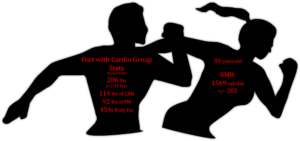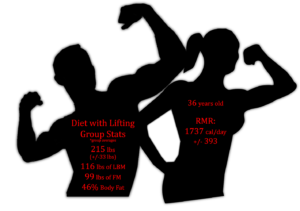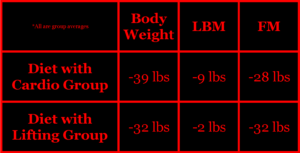Let’s come back down to earth after the Biggest Loser studies and remind ourselves of what happens under more “normal” conditions of weight loss.
With everything that’s been discussed recently about the Biggest Loser studies (2012, 2016, Discussion sections 1.0 & 2.0), I thought that we should take a moment to review what happens under more “normal” conditions of exercise and weight loss.
The paper that we will have in journal club today provides just that kind of information. This 1999 study had participants do two different styles of exercise (cardio or lifting) along with a diet that provided only 800 calories per day (to note, the studies of weight loss that we’ve discussed before have involved 1200+ calories/day).
Given the Biggest Loser results, what happens to resting metabolism (RMR) in this study? Let’s find out!
Methods
This study lasted 12 weeks and had mostly female participants. Below are the descriptive stats for the groups. As always, they’re group averages and rounded to the nearest whole number for the ease of viewing.
They were basically newbies to cardio and resistance exercise. There were 10 in each group. Each had an 800 calories/day liquid diet provided, along with a multi-vitamin. The liquid diet contained 80g protein, 98g carbs, and 10g fat per day.
One group (“diet/cardio”) did cardio exercises (walk, cycle, stairs) 4 days/wk. Each session lasted 50-60 minutes. The other group (“diet/lifting”) did resistance exercises with machines 3 days/wk. They alternated between 6 lifts for the upper body in one session and 4 lifts for the lower body in the next session. The scheme boiled down to 4 sets of 8-12 repetitions and 1 minute of rest between sets. Trainers worked with them and emphasized the use of the heaviest weights possible.
All participants had pre/post measurements of their body composition, VO2 max, RMR, 1RM, and treadmill to failure time. Everyone also had weekly counseling sessions with the researchers about their diet and had weigh-ins to confirm weight-loss.
Results
Everyone lost weight. Below is the breakdown for their weight loss and overall changes in masses.
The diet/cardio group lost more weight, but at the expense of LBM. The diet/lifting group lost a little more fat and essentially preserved LBM (statistically speaking).
The diet/cardio group’s RMR lowered by an average of 13% at the end of the 12 weeks. The diet/lifting group’s RMR increased slightly by 4% at the end of the 12 weeks.
Both groups in this study improved their VO2 maxes. Only the lifting group got stronger.
Nitty Gritty Thoughts & Implications
These body composition changes are not a surprise to us here. We’ve seen similar results before. We repeatedly find that resistance exercise helps maintain LBM (and muscle, specifically) during weight loss. A more refined examination of the body composition changes may have found that cardio helped to prevent LBM loss in the legs, but we can not know in this group. Remember, changes in LBM can vary based on the type of exercise.
This muscle sparing effect of resistance exercise was even seen in the 2012 Biggest Loser study, if you recall. The researchers parsed the change in body composition over the course of the show and muscle tissue was well-preserved. Even in the face of extreme amounts of activity and food deprivation, resistance exercise can have a profound effect on the preservation of muscle.
Resistance exercise, from what we have here, may even help with the preservation of resting metabolism. I say “may” because the researchers explained in the Discussion section of the paper that there are studies which did not find a preservation effect. In this case, though, the resting metabolisms of the diet/lifting group did not decrease despite losing 32 lbs. Their resting metabolisms increased by 4%. The diet/cardio group had a 13% decrease in their resting metabolisms. That decrease is within expected amounts, though, and we would be terribly inaccurate to say that their metabolisms crashed…like we would probably see in a news story.
These participants consumed an 800 calories/day liquid diet and did cardio 4 days a week under supervision…and their resting metabolisms decreased by an average of 210 calories. The standard deviation shows that 68% of the changes in resting metabolisms were within ~300 calories above/below that drop. That means a few didn’t have any change in their metabolisms while a few had a drop of something like 500 calories. Where was the notoriety in the media for these folks? But, I digress. Aside from the fact that weight change and maintenance is a function of total daily metabolism (as in, activity metabolism on top of the resting metabolism), we would be incorrect to think that a 39 lbs lighter person should have the same metabolism. There’s less of them. They’re lighter. Their body expends less effort/energy to do things. We’ve seen this kind of metabolic adaptation before. So on and so forth. We just need to appreciate that there was a range of metabolic responses to the weight loss. Some fared well and some did not.
How did these changes in resting metabolisms compare to the Biggest Loser? By the end of the show, the contestants had an average 29% decrease in their resting metabolisms. That 29% decrease came after the contestants lost an average of 126 lbs over 7 months. The diet/cardio participants in today’s study lost 39 lbs in 3 months. They were no slouches in their rate of weight loss. They lost an average of 3.25 lbs/wk while the contestants lost an average of 4.3 lbs/wk (Yes. Anyone that has seen the show knows that the contestants lose more some weeks and less other weeks. It’s not a constant rate of loss.). There may be something to say for not as dramatic a weight loss adventure for as long as the Biggest Loser if the preservation of your resting metabolism concerns you.
Plain & Simply
Like many times before, we find that resistance exercise can help to achieve a more favorable composition outcome when losing weight. This holds up even when we take such weight loss measures as going on an 800 calories a day liquid diet for 3 months (which is not easy!). Admittedly, doing cardio while on the diet will also get you to lose a lot of weight. We cannot deny that. We also cannot deny that we are not destined to crash our metabolisms. Discussing averages sometimes makes it easy to forget that there’s a range of results. Some metabolisms will end up just fine and others will not. Resistance exercise may just help your metabolism end up fine. Remind yourself of that when you’re not feeling up to picking things up and putting them down.
If you have any questions about this study or anything I said, please feel free to leave a comment. I will get back to you and others may have insight to offer, too. If you have any questions or topic suggestions that you would like answered as a post, then please email me at robert@analyticfitness.com.
Don’t forget to like Analytic Fitness on Facebook, or follow me on Twitter or the other social medias!









POST REPLY